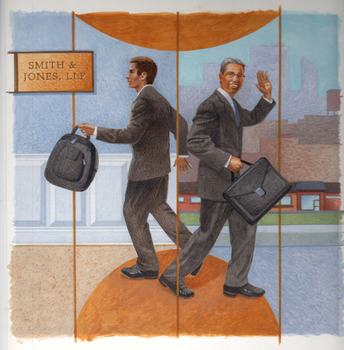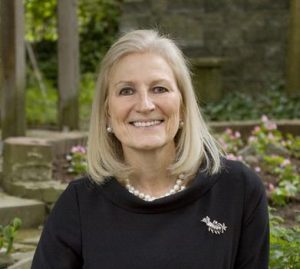Exit Strategies: Aging Partners Are Forcing Firms to Reconsider Retirement
Baby boomers control an outsize portion of law firm business. As they inch toward retirement, how are firms preparing for the transition process?
November 01, 2019 at 05:00 AM
11 minute read
 Image: Shutterstock
Image: Shutterstock
In 2013, Thompson Hine managing partner Deborah Read was astonished to find that attorneys over 59 handled one-third of the firm's client relationships.
"When I first looked at it," she says, "I was taken aback, because we weren't paying too much attention to it."
The firm's expected retirement age was around 65, which meant that the majority of this outsized group of partners would be retiring within a decade. At the time, Thompson Hine had no formal client transition process.
Read realized that the mass retirement of such a large and influential generation had to be handled proactively. If the firm didn't address the issue, she thought, it would lose a large chunk of those clients. Putting together a plan to successfully transition clients en masse became a priority.
Across the legal industry, nearly every firm is facing the same dilemma: How does a firm retain clients as more than a quarter of a firm's relationship partners head toward retirement?
The Pew Research Center defines the baby boomer generation as those born between 1946 and 1964, making the today's youngest baby boomer 55 years old and the oldest 73. The generation is currently the largest, numbering 72 million, all told.
As is the case with Thompson Hine, the generation's control of the purse is significant: Baby boomers handle about 25% of law firm matters, according to Altman Weil consultant Eric Seeger. A 2016 ALM analysis found that nearly half of the Am Law 200 partnership was over age 52.
More than any previous generation, baby boomers are working longer. Pew found that 66% of the younger band of the generation, aged 55 to 65, are still working. In 2018, 29% of baby boomers aged 65 to 72 were still in the work force, a participation rate notably higher than the silent generation (21%) and the greatest generation (19%) at those same ages.
 Credit: Joe Kovach
Credit: Joe KovachWith firms moving away from mandatory retirement ages, experts agree that the best way to manage large waves of retirements and to ensure client retention is to create a thoughtful, long-term process that begins years before a partner retires.
Thompson Hine put just such a process in place after its 2013 revelation. To ensure smooth client transitions, the firm created a formal step-down approach. It enters into an arrangement with a senior partner, transitioning them into an income partner, with their compensation tied to contributions not just toward billing but also toward the transition process.
Clients, potential junior partner successors and timetables are all included in the detailed transition plan. The goal, Read says, is to have a process that respects everybody involved while ensuring that clients are retained after the relationship partner leaves. This retirement process can begin at any age. For example, a Thompson Hine senior partner retired this year at 66 after starting the process in 2014 at 61.
Today, 37% of the firm's clients are handled by partners over age 59—a marginal increase from 2013—and 16 partners are currently going through the retirement process. Read doesn't expect, nor necessarily want, the formal process to affect the influence of senior partners. With a generation so large, she expects the share of clients handled by older partners to hover around one-third for a while. What is most important for Thompson Hine is that it avoids hemorrhaging clients as senior partners retire. And in that respect, Read says, the firm has been very successful.
Eleven partners have transitioned through the retirement process since 2013. Nine of those agreements have resulted in a near-perfect client transition, Read says. The other two didn't have many clients to transition, she notes.
"Because we have a managed process, it doesn't concern me now. There are more important questions than the percentage," Read says. "Are we accomplishing the client transition? Are the clients staying with the firm? For the most part, we've been successful."
Two years ago, Thompson Hine real estate partner Linda Striefsky met Read over breakfast, and the pair talked retirement. Striefsky wanted to join her husband, a former Thompson Hine partner, in retirement bliss and travel across the world. Read wanted to ensure that the firm kept her clients.
Striefsky agreed to take on fewer hours and work to fully transition her long-term clients to junior partners, a process that has been nearly flawless, she says.
But Striefsky says her willingness to retire made the process easier. For many, she acknowledges, retirement is a fraught subject. Some fear that they'll be lost without the prestige, the constant calls and lunches. Others lost a large portion of their savings in the 2008 recession or aren't in two-income families, like Striefsky and her husband.
 Deborah Read of Thompson Hine
Deborah Read of Thompson HineSome partners considering retirement avoid even bringing up the subject for fear that a firm might push them to transition their clients and work less, she says. Others may go the opposite route, as Striefsky's husband did, and retire quickly, shelving their cellphones in celebration and gleefully ignoring their email inboxes.
No matter the specifics of a partner's situation or the difficulties that might arise, Striefsky says it's important to have a process that can account for the varied perspectives on retirement. In exchange for working to transition clients, Thompson Hine compensated her to reflect her efforts—a factor she thinks is important in a smooth transition.
"I didn't think I was being penalized." Striefksy says. "You have to think of ways to give incentives. It's going to happen. The question is: Are you going to handle it in a way that's mutually agreeable? You don't want to lose the clients and you don't want a grumpy partner taking their relationships to another law firm."
Incentivizing partners by tying their compensation to transition outcomes is one of the most important factors in successful retirement processes, says Kent Zimmermann, a principal with consulting firm Zeughauser Group. Relying on the traditional billing and origination model rewards senior partners for hanging onto their clients as long as possible.
"Firms that are effective in this front tie transitions to money," Zimmermann says. "It's important to align the firm's interest with the partner's interest, using money. Some firms use a carrot, some use a stick, some both."
Day Pitney is looking to tweak its compensation model as it works to finalize its own formal retirement process within months so it will be prepared for the large number of senior partners at the firm who are between the ages of 65 and 73.
In the past, the firm had an informal system that began with a pilot program for the firm's senior trusts and estates partners. The firm worked with senior partners individually to reduce hours and client responsibilities, compensating them in an ad hoc manner, where transition success wasn't always a factor.
 Gregory Hayes of Day Pitney
Gregory Hayes of Day PitneyDay Pitney executive committee member and partner Gregory Hayes says the firm is now looking at a somewhat different financial paradigm, one that always ties compensation to successful transitions.
"We believe that the compensation for a partner in transition should in part reflect the success—or lack thereof—of that transition," Hayes says. "It is important that we reward and incentivize successful transition."
White & Case meets with its senior partners at 55 and 60, and partners approaching retirement age are evaluated by their transition progress in addition to the typical benchmarks. The firm had a mandatory retirement age of 65, but did away with it earlier in the decade, deciding that the "one-size-fits-all" approach to retirement wasn't working.
"It's a healthy approach to not have a black-and-white rule," Cheryl Fernstrom, global head of partner resources at White & Case, says. "We want to make sure we're doing the best for our clients and partners and firm."
Fernstrom says it's important for firms to help prepare partners financially and personally. White & Case helps draft financial plans for its transitioning partners.
"Retirement is a daunting thing for many lawyers," Fernstrom says. "We really try to help make sure partners feel confident that they're ready to retire from a financial standpoint when they're personally and professionally ready."
The Rising Generation
Retiring partners and their clients are only part of the conversation. The third piece of a successful transition lies with the junior partners ascending to roles once held by senior partners. Altman Weil's Seeger says high-quality talent for the next generation comes at a premium, pointing to the sluggish law school enrollment numbers since the Great Recession.
"The best and brightest stopped going to law schools 10 years ago," Seeger says.
Orrick, Herrington & Sutcliffe is among the group of firms that has formalized its transition process, creating a senior partnership made up of partners who have told the firm they are within three to five years of retiring. The firm did not disclose how many senior partners it has.
Senior partners are expected to specifically identify a junior partner to sponsor, coaching them and transitioning their practice year by year. Orrick has tied this process to a partner's annual performance review, and by extension compensation, providing written feedback and expectations to the senior partner.
"[The role] enables the next generation to tap into the incredible experience and judgment of these senior partners, while providing senior partners with a focus that most of them find highly rewarding," Orrick chair Mitch Zuklie says.
The firm also asked 20 of its junior partners in 2017 to participate in an innovative commission that advises and pitches to the firm's executive board. The so-called Higgins Commission looks at four specific areas: clients, collaboration, talent and innovation. Zuklie sees the commission as a way for Orrick to get future leaders engaged early.
Goodwin Procter has also taken steps to prepare its future leaders by putting them in leadership roles early. Two members of the firm's executive committee must have been a partner at the firm for less than 10 years.
"Young attorneys have a certain perspective on how things should be done," says David Hashmall, who stepped down as the firm's chair in October. "There's no question that having a wide perspective benefits a firm."
The other part of the equation, Seeger says, lies in successfully retaining high-performing junior partners. "The senior partners have to have confidence in the more junior people or they are not going to transition clients," he says.
Retaining top talent was a driving force behind Weil, Gotshal & Manges' decision to shorten its partnership track from nine to seven years and institute a formal feedback session for fifth-year associates that begins next year.
"Given that we're in the professional services business, we have to continue to attract, retain and promote top talent," says executive partner Barry Wolf. "Our assets go up and down in the elevator."
Development tools such as the classes the firm offers at the Columbia Business School ensure that junior partners are more successful in inheriting clients from their senior counterparts, says Jacquelyn Knight, a consultant at Major, Lindsey & Africa.
"The firms that do the best at succession prepare the associates and counsel with coaching and tools to develop business," Knight says. "They're not just getting the client. They're tasked with growing the business and building a new team."
Wolf also believes it's imperative to give junior partners leadership positions early on by placing them on committees or task forces such as the one that was responsible for developing and pitching Weil Gotshal's management committee on the associate evaluation and partnership track changes. Typically, he says, Weil Gotshal junior partners are on at least one committee
These assignments double as a way for firm leadership to gauge who shows leadership potential early on, as well as an opportunity for junior partners to be introduced to other partners and the inner-workings of the firm.
"We see how they respond to [a committee assignment] and handle it," Wolf says. "Some people show leadership ability and some don't. It helps us get to the educated decision on who should lead."
In Striefsky's experience, though, no amount of grooming can fully guarantee a successful transition.
"It's not just your decision," she says. "In the end, it's what the client wants."
Email: [email protected]
This content has been archived. It is available through our partners, LexisNexis® and Bloomberg Law.
To view this content, please continue to their sites.
Not a Lexis Subscriber?
Subscribe Now
Not a Bloomberg Law Subscriber?
Subscribe Now
NOT FOR REPRINT
© 2025 ALM Global, LLC, All Rights Reserved. Request academic re-use from www.copyright.com. All other uses, submit a request to [email protected]. For more information visit Asset & Logo Licensing.
You Might Like
View All
Law Firms Look to Gen Z for AI Skills, as 'Data Becomes the Oil of Legal'

Law Firms Expand Scope of Immigration Expertise Amid Blitz of Trump Orders
6 minute read
Losses Mount at Morris Manning, but Departing Ex-Chair Stays Bullish About His Old Firm's Future
5 minute read
Trending Stories
- 1Uber Files RICO Suit Against Plaintiff-Side Firms Alleging Fraudulent Injury Claims
- 2The Law Firm Disrupted: Scrutinizing the Elephant More Than the Mouse
- 3Inherent Diminished Value Damages Unavailable to 3rd-Party Claimants, Court Says
- 4Pa. Defense Firm Sued by Client Over Ex-Eagles Player's $43.5M Med Mal Win
- 5Losses Mount at Morris Manning, but Departing Ex-Chair Stays Bullish About His Old Firm's Future
Who Got The Work
J. Brugh Lower of Gibbons has entered an appearance for industrial equipment supplier Devco Corporation in a pending trademark infringement lawsuit. The suit, accusing the defendant of selling knock-off Graco products, was filed Dec. 18 in New Jersey District Court by Rivkin Radler on behalf of Graco Inc. and Graco Minnesota. The case, assigned to U.S. District Judge Zahid N. Quraishi, is 3:24-cv-11294, Graco Inc. et al v. Devco Corporation.
Who Got The Work
Rebecca Maller-Stein and Kent A. Yalowitz of Arnold & Porter Kaye Scholer have entered their appearances for Hanaco Venture Capital and its executives, Lior Prosor and David Frankel, in a pending securities lawsuit. The action, filed on Dec. 24 in New York Southern District Court by Zell, Aron & Co. on behalf of Goldeneye Advisors, accuses the defendants of negligently and fraudulently managing the plaintiff's $1 million investment. The case, assigned to U.S. District Judge Vernon S. Broderick, is 1:24-cv-09918, Goldeneye Advisors, LLC v. Hanaco Venture Capital, Ltd. et al.
Who Got The Work
Attorneys from A&O Shearman has stepped in as defense counsel for Toronto-Dominion Bank and other defendants in a pending securities class action. The suit, filed Dec. 11 in New York Southern District Court by Bleichmar Fonti & Auld, accuses the defendants of concealing the bank's 'pervasive' deficiencies in regards to its compliance with the Bank Secrecy Act and the quality of its anti-money laundering controls. The case, assigned to U.S. District Judge Arun Subramanian, is 1:24-cv-09445, Gonzalez v. The Toronto-Dominion Bank et al.
Who Got The Work
Crown Castle International, a Pennsylvania company providing shared communications infrastructure, has turned to Luke D. Wolf of Gordon Rees Scully Mansukhani to fend off a pending breach-of-contract lawsuit. The court action, filed Nov. 25 in Michigan Eastern District Court by Hooper Hathaway PC on behalf of The Town Residences LLC, accuses Crown Castle of failing to transfer approximately $30,000 in utility payments from T-Mobile in breach of a roof-top lease and assignment agreement. The case, assigned to U.S. District Judge Susan K. Declercq, is 2:24-cv-13131, The Town Residences LLC v. T-Mobile US, Inc. et al.
Who Got The Work
Wilfred P. Coronato and Daniel M. Schwartz of McCarter & English have stepped in as defense counsel to Electrolux Home Products Inc. in a pending product liability lawsuit. The court action, filed Nov. 26 in New York Eastern District Court by Poulos Lopiccolo PC and Nagel Rice LLP on behalf of David Stern, alleges that the defendant's refrigerators’ drawers and shelving repeatedly break and fall apart within months after purchase. The case, assigned to U.S. District Judge Joan M. Azrack, is 2:24-cv-08204, Stern v. Electrolux Home Products, Inc.
Featured Firms
Law Offices of Gary Martin Hays & Associates, P.C.
(470) 294-1674
Law Offices of Mark E. Salomone
(857) 444-6468
Smith & Hassler
(713) 739-1250










